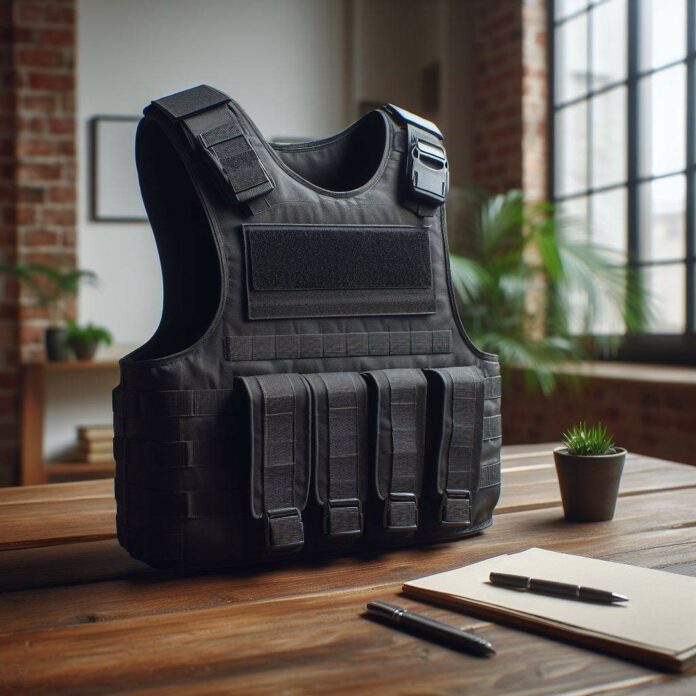Cleaning a bulletproof vest is an essential part of its maintenance to ensure its effectiveness and longevity. Explore efficient methods on how to preserve and clean a bulletproof vest to enhance its performance and ensure long-lasting durability.
Understanding the materials used in bulletproof vests is crucial before delving into the cleaning process. By knowing the construction and composition of the vest, you can better choose appropriate cleaning methods.
Regularly cleaning a bulletproof vest is of utmost importance. Accumulated dirt, sweat, and other contaminants can compromise its protective capabilities, cleaning helps remove odor and maintain overall hygiene.
Before cleaning, it is essential to prepare the bulletproof vest properly. This includes removing any attachments or accessories and checking for any damage or wear that may require repair.
Cleaning techniques for bulletproof vests can vary based on the materials used. We will explore both hand-washing and machine-washing methods and discuss their pros and cons.
Once the cleaning process is complete, it is crucial to dry and store the bulletproof vest correctly. Proper air-drying techniques and suitable storage methods will help maintain its shape and protect its integrity.
Conducting regular inspections for damage after cleaning and knowing when it’s time to replace the vest are important aspects of caring for your protective gear.
Understanding the Materials Used in Bulletproof Vests
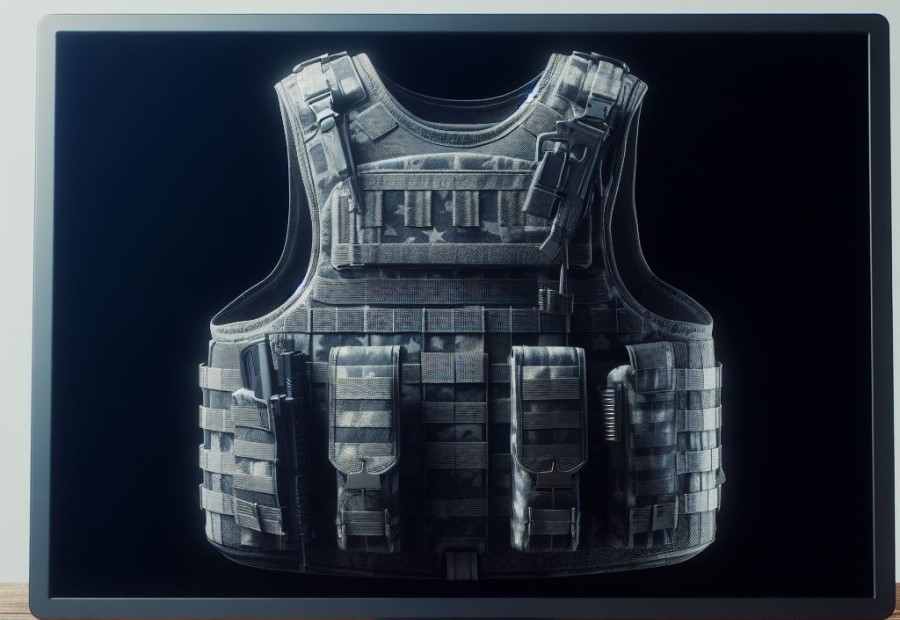
Bulletproof vests are designed to provide protection against bullets by incorporating a variety of materials. These materials, such as Kevlar , Twaron , and Dyneema , are known for their high strength-to-weight ratio.
Strong fibers like these are woven together to form layers, which contribute to the vest’s ability to stop bullets. In some cases, ceramic or metallic plates may also be included to enhance the vest’s resistance against armor-piercing bullets.
To truly grasp the effectiveness and level of protection provided by bulletproof vests, it is crucial to understand the materials used. It’s worth noting that the performance of bulletproof vests can vary based on the specific materials and design.
Therefore, when looking to purchase a bulletproof vest, it is essential to thoroughly research and comprehend the materials used, allowing for an informed decision that prioritizes personal safety.
What Are Bulletproof Vests Made Of?
Bulletproof vests are made of several layers of specialized materials that work together to provide protection against bullets.
The main materials used in bulletproof vests include strong fibers, such as Kevlar, Twaron, or Dyneema, and a woven or laminated fabric layer.
These fibers are known for their high tensile strength, which allows them to withstand the force of a bullet and prevent it from penetrating the vest.
In addition to these fibers, bulletproof vests may also have ceramic or metallic plates inserted into pockets to enhance their protective capabilities.
These plates are made of materials like steel or ceramic composites, which are able to absorb and disperse the impact energy from a bullet, reducing the risk of injury.
Bulletproof vests are designed to be lightweight and flexible, allowing the wearer to move freely while still providing effective protection. The materials used in their construction are chosen for their durability and resistance to wear and tear.
Why Regularly Clean a Bulletproof Vest?
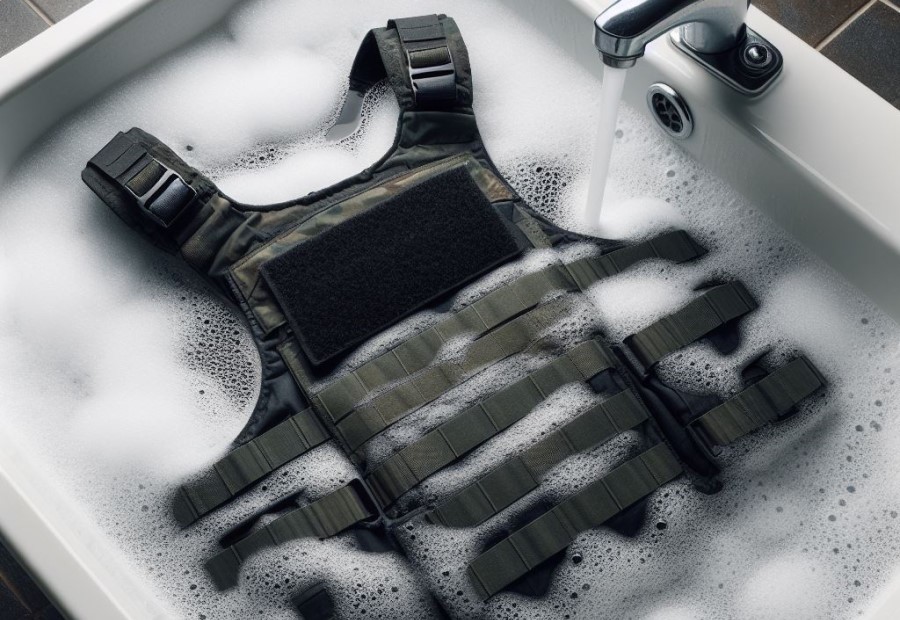
Regularly cleaning a bulletproof vest is of utmost importance. It enhances the longevity of the vest by removing dirt, sweat, and other contaminants that can degrade its protective capabilities over time.
Additionally, cleaning preserves the performance of the vest, ensuring that the ballistic panels and other components remain in optimal condition and can function effectively when needed.
Moreover, maintaining a clean vest is crucial for comfort, as it eliminates odors and prevents the buildup of bacteria, which can cause skin irritation.
Furthermore, regular cleaning ensures hygiene by removing any blood, bodily fluids, or other substances that may be present on the vest, thus reducing the risk of infection and cross-contamination.
Preparing the Bulletproof Vest for Cleaning
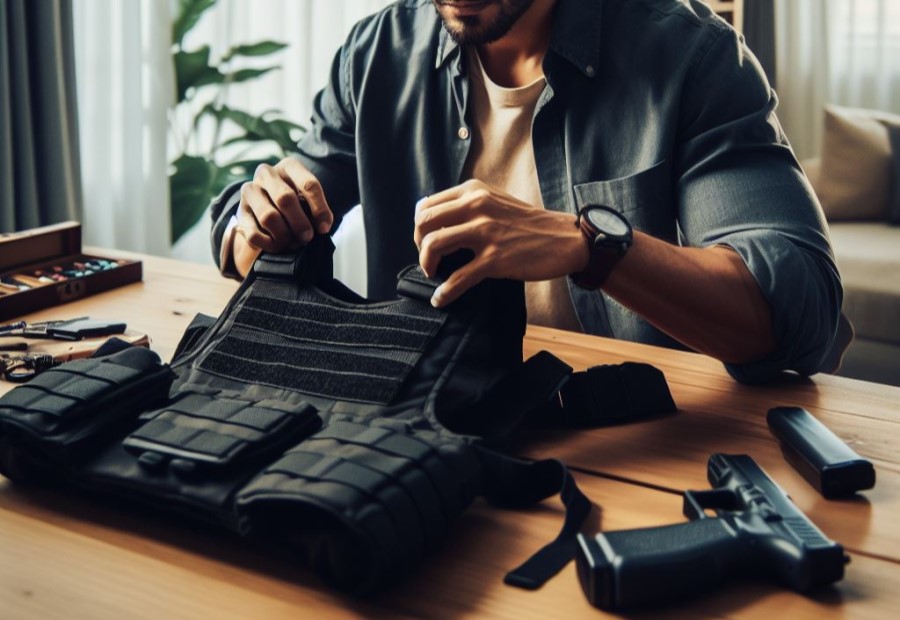
Removing any Attachments or Accessories
When removing any attachments or accessories from a bulletproof vest, it is important to handle them with care to avoid damaging the vest or the items themselves. Follow these steps:
- Start by carefully examining the vest for any attachments or accessories such as patches, badges, or additional armor plates. Take note of any straps or fasteners that may be holding them in place.
- Remove any patches or badges by gently peeling or unsticking them from the vest.
- If there are additional armor plates attached, carefully detach them according to the manufacturer’s instructions.
- Unfasten any straps or fasteners that may be holding accessories in place.
- During the cleaning process, keep all attachments and accessories in a safe place to prevent loss or damage.
By following these steps, you can effectively and efficiently remove any attachments or accessories from the bulletproof vest.
Checking for Damage or Wear
When checking for damage or wear on a bulletproof vest, it is important to follow these steps:
- Inspect the exterior of the vest for any visible signs of damage, such as tears, punctures, or fraying.
- Check the straps, buckles, and Velcro closures to ensure they are in good condition and securely attached.
- Examine the ballistic panels for any bulges, lumps, or uneven areas, as this could indicate internal damage.
- Run your hands over the surface of the vest to feel for any abnormalities, such as hard spots or deformities.
- Check the stitching and seams to ensure they are intact and not coming undone.
- If the vest has been exposed to water or extreme heat, check for any changes in color or texture, as this could indicate damage.
- Consider the age and usage of the vest. If it has been used in high-stress situations or has been worn consistently for a long time, it may be more prone to wear and tear.
By thoroughly checking for damage or wear on your bulletproof vest, you can ensure that it remains in optimal condition and continues to provide the necessary protection.
The concept of body armor can be traced back to ancient times, where various materials such as animal hides and metal plates were used to protect warriors in battle.
However, it wasn’t until the late 1800s that the first modern bulletproof vests were developed. These early versions were made from layers of silk or cotton and proved to be somewhat effective against low-velocity bullets.
Over the years, advancements in materials and technology led to the development of more reliable and lightweight bulletproof vests.
Cleaning Techniques for Bulletproof Vests
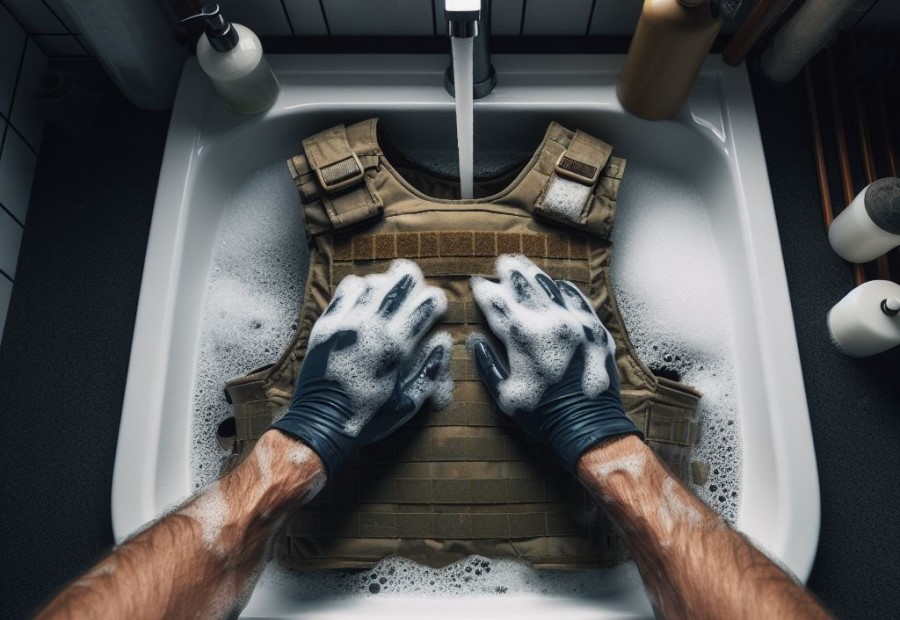
Hand-Washing Method
The Hand-Washing Method is an effective way to clean a bulletproof vest and ensure its longevity and effectiveness. Here is a step-by-step guide:
- Fill a basin or sink with warm water.
- Add a small amount of mild detergent and mix it well.
- Remove any attachments or accessories from the vest.
- Gently submerge the vest in the soapy water.
- Using your hands, agitate the water and gently scrub the vest to remove dirt and stains.
- Pay extra attention to any areas that are particularly dirty or stained.
- Rinse the vest thoroughly with clean water until all the soap residue is gone.
- Press the vest gently to remove excess water without wringing or twisting it.
- Hang the vest in a well-ventilated area to air dry completely.
- Once the vest is dry, ensure that all attachments and accessories are securely reattached.
To maintain the effectiveness of the vest, avoid using bleach or harsh chemicals during the cleaning process. Additionally, do not machine wash or tumble dry the vest as it can damage the ballistic panels.
Regularly inspect the vest for any signs of damage or wear after cleaning and follow the manufacturer’s guidelines for replacing the vest when necessary.
Machine-Washing Method
The machine-washing method, an effective way to clean a bulletproof vest, incorporates the following steps:
- Make sure the bulletproof vest is machine-washable, adhering to the care instructions provided by the manufacturer.
- Before washing, detach any attachments or accessories from the vest.
- To prevent any damage to the vest or washing machine, close all fastenings, like zippers or Velcro.
- For protection during the washing process, place the bulletproof vest in a mesh laundry bag.
- Select a gentle cycle on the washing machine using cold water.
- When adding detergent to the machine, opt for a mild one to avoid vest damage caused by bleach or harsh chemicals.
- Initiate the machine-washing cycle and let it complete.
- Once the cycle is finished, cautiously remove the bulletproof vest from the laundry bag.
- Inspect the vest for any indications of damage or wear, paying close attention to the stitching and fabric integrity.
- Hang the vest in a well-ventilated area to air dry. Avoid exposing it to direct sunlight or high heat since it may affect the vest’s performance.
- After the vest is fully dry, store it in a cool and dry place away from sharp objects or heavy items that could cause deformation.
By following these steps, you can ensure that your bulletproof vest remains clean and in optimal condition.
Drying and Storing a Bulletproof Vest
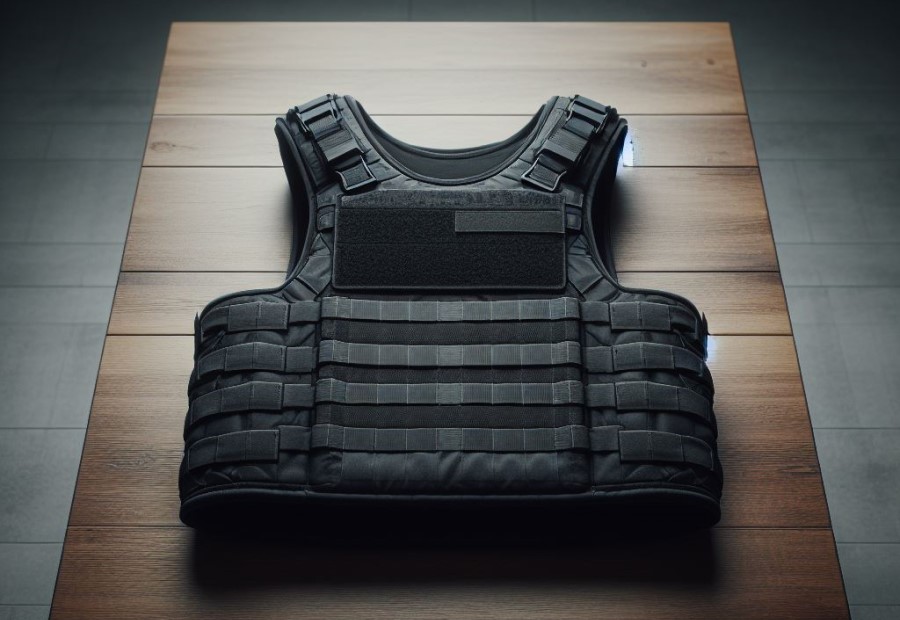
Air Drying
When it comes to drying a bulletproof vest, air drying is the recommended method to ensure its effectiveness and longevity.
- After cleaning the vest, gently squeeze out any excess water.
- Lay the vest flat on a clean, dry surface, away from direct sunlight and heat sources.
- Allow the vest to air dry naturally, ensuring proper airflow around the entire vest.
- Turn the vest over periodically to ensure both sides are drying evenly.
- Avoid using a clothesline or hanging the vest, as this can cause the straps or materials to stretch.
- Do not use a dryer or any artificial heat source to dry the vest, as this can compromise the vest’s integrity.
- Monitor the drying process, ensuring there is no moisture remaining before storing the vest.
Air drying is crucial to prevent damage to the vest’s materials and maintain its protective capabilities. By following these steps, you can ensure that your bulletproof vest is properly dried and ready for storage or future use.
Proper Storage Techniques
Proper storage techniques are essential for maintaining the effectiveness and longevity of a bulletproof vest.
- Clean and dry: Before storing the vest, it is important to ensure that it is clean and dry to prevent the growth of mold or mildew.
- Avoid exposure to extreme temperatures: Store the bulletproof vest in a cool, dry place away from direct sunlight or extreme heat, as this can cause the materials to deteriorate.
- Avoid folding or compressing: Excessive folding or compressing of the vest should be avoided, as this can damage the protective fibers. Instead, it is recommended to hang or store it flat to maintain its shape.
- Keep away from chemicals: It is important to store the vest away from any chemicals or substances that could potentially degrade the materials.
- Regularly inspect: It is essential to periodically check the vest for any signs of damage or wear, such as tears or loose stitching. If any issues are found, they should be addressed immediately.
- Protect from moisture: Consider storing the vest in a breathable cotton or mesh bag to protect it from moisture while still allowing air circulation.
By following these proper storage techniques, you can ensure that your bulletproof vest remains in optimal condition and is ready for use when needed.
Additional Care and Tips for Bulletproof Vests
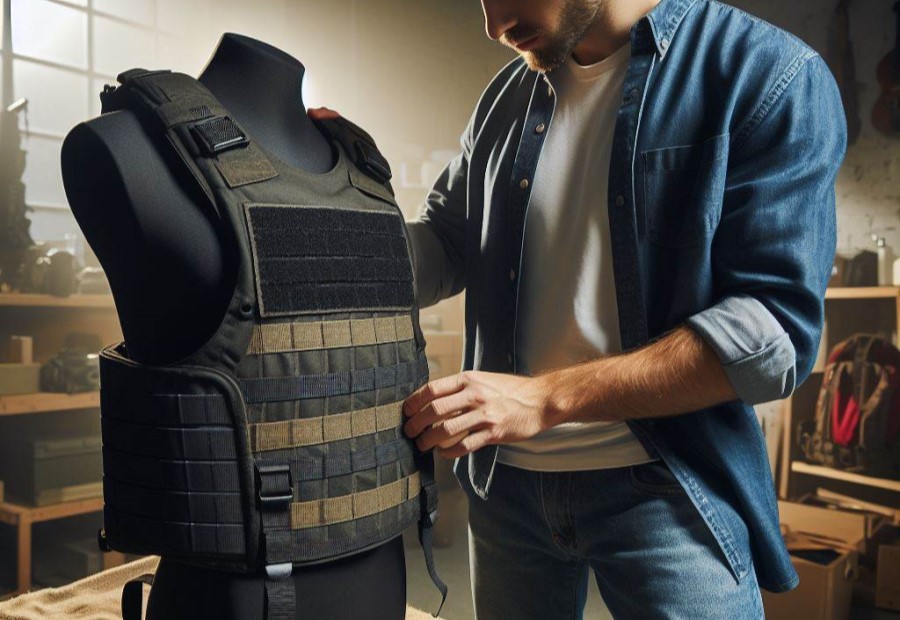
Inspecting for Damage after Cleaning
After the cleaning process, it is crucial to inspect the bulletproof vest for any potential damage. This ensures that the vest remains effective and durable.
- Always check the surface of the vest for any visible tears or punctures. These can significantly impact the vest’s integrity and its ability to stop bullets.
- Run your fingers along the seams to detect any loose or frayed threads. Promptly repair these to prevent further damage.
- Take a close look at the Velcro straps or buckles to identify any signs of wear or damage. These components are essential for securely fastening the vest and should be replaced if they are worn out.
- Pay attention to the straps and fasteners used to adjust the vest’s fit. Make sure they are in good condition and functioning correctly.
- Inspect any accessories or attachments that were removed before cleaning. Check for any damage or wear, such as pockets, trauma plates, or ballistic panels that may have been detached.
- Examine the ballistic panels or inserts carefully for any bulges, unusual discoloration, or irregularities. These could indicate damage or degradation of the protective material.
- Ensure that all components of the vest are securely reattached after cleaning. Double-check that nothing is loose or misaligned.
- Lastly, perform a fit test with the vest on to verify that it sits properly and provides adequate coverage. Make necessary adjustments if needed.
Knowing When to Replace the Vest
Regular inspections are necessary to ensure the vest remains effective in providing protection. It is important to note that bulletproof vests have a limited lifespan and should be replaced accordingly.
Inspect the vest for any signs of damage or wear. Look for any punctures, tears, or fraying of the material. If any damage is detected, individuals should replace the vest immediately as it may compromise its ability to stop projectiles.
Consider the usage of the vest. If the vest has been worn daily or exposed to extreme conditions, its lifespan may be shorter.
Vests used in high-risk professions such as law enforcement or the military may require more frequent replacement compared to vests used in low-risk situations.
Take into account the manufacturer’s guidelines. They often provide recommendations on the expected lifespan of the vest.
Knowing when to replace the vest is essential, and individuals should follow these guidelines to ensure optimal performance and protection.
Regularly review advancements in bulletproof vest technology. As new materials and designs are developed, older vests may become outdated and less effective.
Staying informed about industry updates is crucial in making an informed decision on when to replace the vest.
Frequently Asked Questions
How often should I clean my bulletproof vest?
It is recommended to clean your bulletproof vest at least once a week to remove sweat and dirt buildup. However, it’s important to follow the manufacturer’s instructions for specific cleaning guidelines.
Can I machine wash my ballistic vest?
Most ballistic vests cannot be machine washed as it may damage the delicate fabrics and compromise their ballistic protection. However, some plate carriers may be machine washed if allowed by the manufacturer.
What should I use to spot clean my armor?
You can spot clean your bulletproof vest using a damp cloth and mild detergent, such as Dawn dish soap. Avoid using alcohol or bleach wipes as they may damage the vest.
Can I use a moisture-wicking shirt under my vest?
Yes, wearing a moisture-wicking shirt underneath your bulletproof vest can help absorb sweat and reduce discomfort. It creates a barrier between your skin and the vest, reducing the risk of developing a rash.
How do I eliminate sweaty odors from my vest?
Arrest My Vest Spray is a high-quality odor eliminating spray specifically made for bulletproof vests and tactical gear. It uses odor-absorbing molecules to break down and eliminate odors on contact.
What should I avoid to prevent damaging my bulletproof vest?
To prevent damaging your vest, avoid soaking it in water, using bleach or strong cleaning agents, and machine washing or drying it. It is important to follow the manufacturer’s instructions and avoid repeatedly going against them.

